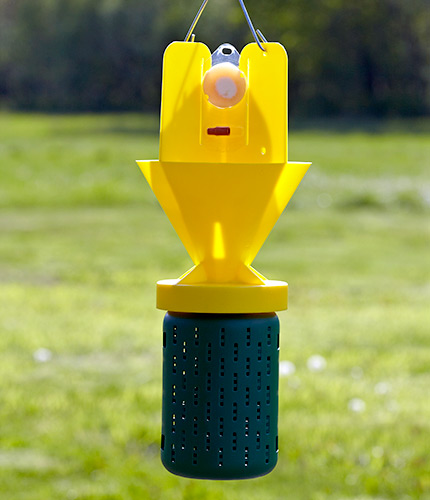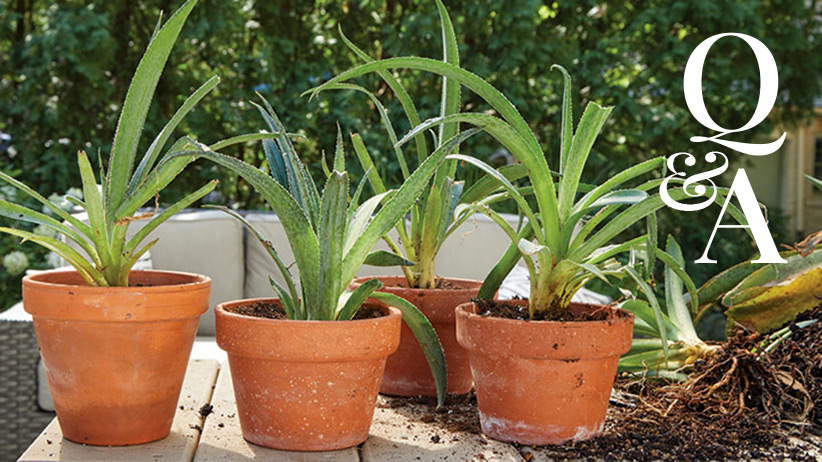The dreaded Japanese beetle
One day your zinnias are colorful and bright. The next, you notice gnawed and ragged petals. Upon closer examination, iridescent green bugs, like the ones in the photo above, are tucked way down in the blossoms. Japanese beetles (Popillia japonica) have found your garden! This pest is working its way across North America. So even if you don’t think your area has them, it’s wise to be on the lookout.
Where Japanese beetles have been around for years, natural predators are helping keep them in check. But in areas where they’ve just arrived, these pests can be voracious eating machines. It’s time to prepare your defenses before they devour your garden! Keep scrolling to learn more about the beetles life cycle, plants they love and ways to control them.
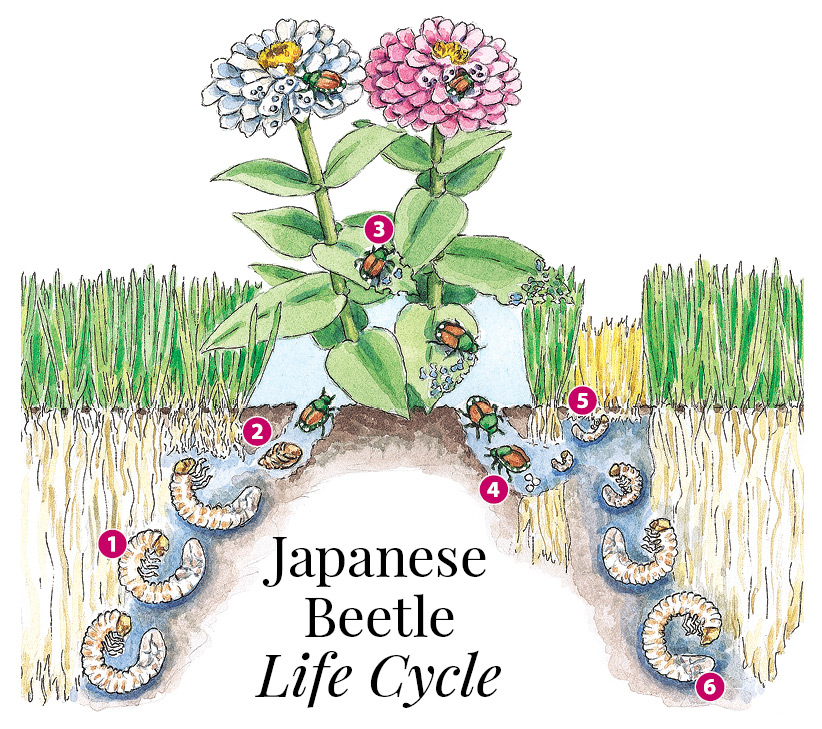
Japanese beetle life cycle
It’s not easy to spot the Japanese beetle at first. That’s because much of its life cycle takes place underground. After the egg hatches in summer, the grub feeds on roots until the following summer when it emerges as a shiny beetle. Here are the stages in the lifecycle of a Japanese beetle.
1) Grubs emerge
After wintering deep in the soil, grubs hatched the previous summer rise to the surface in late spring to feed on roots. This is a good time to apply pesticides.
2) Ready for a change
In late spring, the grub forms a pupa 1 to 3 in. deep in the soil. In a few weeks, the adult hatches and crawls to the surface.
3) Looking for food and a mate
Adults emerge in midsummer to eat flowers and foliage. They release pheromones, or odors, that attract other Japanese beetles for mating.
4) Lots of eggs
After mating, females burrow 2 to 4 in. into the soil to lay 1 to 5 eggs. Then they return to the plants to feed and mate. This cycle continues during the heat of summer until 40 to 60 eggs have been laid.
5) Hungry grubs
Eggs hatch in 8 to 14 days, and the small grubs feed on roots and other organic materials. As they grow, they shed their skin several times. Pull back sod in late summer. If you find grubs like the ones in this photo below, it’s a good time to work on a control.
6) Back to sleep
As autumn temperatures drop, the 1-in.-long, fat grubs go 6 to 18 in. into the soil to spend the winter.

Japanese beetle grub damage & control
In spring and late summer, the larva, or grub, can be as destructive as the adult, finding the roots of your turf to be the perfect food. Without a full root system, grass struggles to gather enough water to survive. One of the best ways to determine grub activity is shown in the photo above. If you can easily pull turf away like a rug and discover grubs underneath, it’s time to work on a control.
When to apply control for Japanese beetle grubs
Late spring to early fall, coinciding with the times grubs are near the soil surface, are the best times to apply a control. If you prefer a chemical, look for either a spray or a granular material that contains imidacloprid or halofenozide.
Organic grub control
Milky spore, a bacteria you mix with water and sprinkle on the lawn, has killed grubs in some regions. However, studies are still out as to how effective it really is in all areas. If you want to try milky spore, many garden centers carry it or you can purchase it online.
You Might Also Like:
7 Garden Pests to Look Out For
What to Do About Boxwood Blight
7 Common Garden Diseases
10 Invasive Plants to Avoid in Your Garden
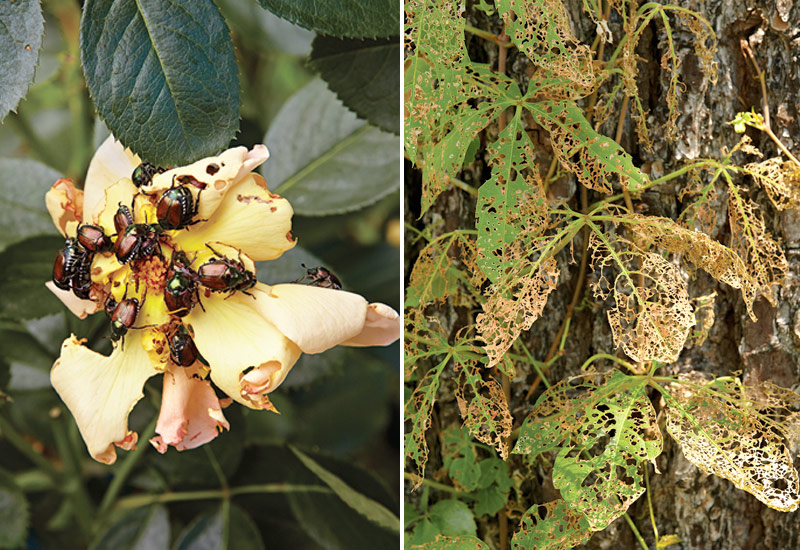
How to deal with adult Japanese beetles
In summer, adults hatch and emerge from the soil to start feeding and mating. A multipronged approach is your best bet to control Japanese beetles. Start by spraying the affected plants with a pyrethrin-based insecticide or neem oil.
- Pyrethrin is a safe and effective way to control these obnoxious pests on raspberries, grapes, flowers and vegetables.
- Neem oil is derived from a tree and it reduces the feeding by the beetles (it’s called an antifeedant). Neem oil works best if applications are started at the first sign of attack.
Hand-picking
Lucky for us, Japanese beetles are slow-moving. Early morning, when they’re still sluggish and less alert from the cool night temperatures, is a good time to pluck or shake the beetles from plants. You can squish them or drop them into warm soapy water for a quick kill.
Japanese beetle traps
Not ready to start swapping out plants? There are traps to attract adult beetles. Japanese beetle traps, like the one in the photo above, have good points, but the cons may outweigh the pros. They’re baited with floral scents and sex pheromones to attract Japanese beetles. The bait is so attractive that it tends to draw beetles from as far away as 1,000 ft. Instead of solving the problem, a trap could make it worse unless you can put it far enough away from anything you don’t want the beetles to eat.
Systemic insecticides
And systemic insecticides, such as those containing imidacloprid or thiamethoxam, are absorbed into the plant, giving long-term protection to ornamentals. Contact insecticides like carbaryl, sold as Sevin®, can be applied as a spray or a dust. They stick only to the surface of the flower or leaf and need to be applied more often.
You Might Also Like:
DIY Fungus Fighting Recipes for the Garden
Poison Ivy Lookalikes
Deer and Rabbit Resistant Plants
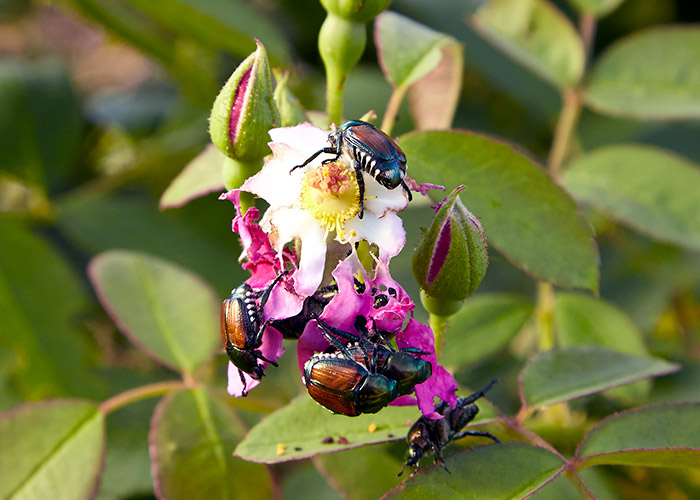
Plants that Japanese beetles like & dislike
If you’re having a hard time staying ahead of the beetles, you may have to make changes to your garden. Japanese beetles feed on lots of plants. But it helps to know their likes and dislikes. If you plant more of the ones they won’t eat and avoid plants from the list of favorites, they may skip your garden altogether!
Plants Japanese beetles dislike
- Coral bells Heuchera spp. and hybrids
- Coreopsis Coreopsis spp. and hybrids
- Delphinium Delphinium spp. and hybrids
- Foxglove Digitalis spp.
- Hosta Hosta spp. and hybrids
- Impatiens Impatiens spp. and hybrids
- Lantana Lantana spp. and hybrids
- Nasturtium Tropaeolum majus
Japanese beetles’ favorite plants
- Clematis Clematis spp. and hybrids
- Dahlia Dahlia hybrids
- Hibiscus Hibiscus spp. and hybrids
- Hollyhock Alcea rosea
- Japanese maple Acer palmatum
- Linden Tilia spp. and hybrids
- Rose Rosa spp. and hybrids
- Sunflower Helianthus spp. and hybrids
- Zinnia Zinnia spp. and hybrids




